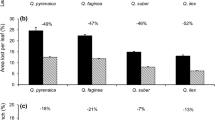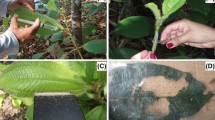Abstract
Plants use different defense strategies throughout their ontogenetic development. In this study, three questions were proposed: (1) Is there a greater abundance of ants on young leaves, which possess active extrafloral nectaries, than on mature leaves? (2) Do ants exert an indirect defense that is effective against the attack of herbivorous insects? (3) Do mature leaves have a greater concentration of physical and chemical defense than young leaves? These questions were addressed through an ant-exclusion experiment in which two branches of Copaifera langsdorffii (n = 25) were marked and monitored throughout the entire foliar expansion and development period. A reduction in the abundance of ants throughout foliar development was observed. The ants exerted an effective defense against herbivores on C. langsdorffii: the branches where ants were excluded had a greater number of herbivores. The mature leaves possessed a greater index of leaf sclerophylly than young leaves, but the leaves did not differ in the concentration of tannins. The foliar ontogeny of C. langsdorffii promoted an inversion in the defense strategy against herbivores, and despite showing an opportunistic relationship, the interaction between ants and extrafloral nectaries appears to play an important role in structuring the interactions between herbivorous insects and their host plants.



Similar content being viewed by others
References
Agarwal VM, Rastogi N (2009) Spatiotemporal dynamics and plant-part preference patterns of the plant-visiting ants and the insect herbivores of sponge gourd plants. J Asia Pacific Entomol 12:57–66
Almeida SP, Proença CEB, Sano SM, Ribeiro JF (1998) Cerrado: Espécies vegetais úteis. Embrapa, Planaltina
Bentley BL (1976) Plants bearing extrafloral nectaries and associated ant community interhabitat differences in the reduction of herbivore damage. Ecology 57:815–820
Bentley BL (1977) The protective function of ants visiting the extrafloral nectaries of Bixa orellana l. (Bixaceae). J Ecol 65:27–38
Bixenman RJ, Coley PD, Kursar TA (2011) Is extrafloral nectar production induced by herbivores or ants in a tropical facultative ant–plant mutualism? Oecologia 165:417–425
Blüthgen N, Fiedler K (2004) Preferences for sugars and amino acids and their conditionality in a diverse nectar-feeding ant community. J Anim Ecol 73:155–166
Blüthgen N, Verhaagh M, Goitía W, Jaffé K, Morawetz W, Barthloot W (2000) How plants shape the ant community in the amazonian rainforest canopy: the key role of extrafloral nectaries and hemipteran honeydew. Oecologia 125:229–240
Blüthgen N, Gottsberger G, Fiedler K (2004a) Sugar and amino acid composition of ant-attended nectar and honeydew sources from an Australian Rainforest. Austral Ecol 29:418–429
Blüthgen N, Stork NE, Fiedler K (2004b) Bottom-up control and co-occurrence in complex communities: honeydew and nectar determine a rainforest ant mosaic. Oikos 106:344–358
Borror DJ, Triplehorn CA, Johnson NF (2002) An introduction to the study of insects. Saunders College Publing, Philadelphia
Campos RI, Lopes CT, Magalhães WCS, Vasconcelos HL (2008) Estratificação vertical de formigas em cerrado strictu sensu no Parque Estadual da Serra de Caldas Novas, Goiás, Brasil. Iheringia 98:311–316
Chamberlain SA, Holland JN (2009) Quantitative synthesis of context dependency in ant–plant protection mutualisms. Ecology 90:2384–2392
Coley PD (1983) Herbivory and defensive characteristics of tree species in a Lowland Tropical Forest. Ecol Monogr 53:209–234
Coley PD, Aide TM (1991) Comparison of herbivory and plant defenses in temperate and tropical broad- leafed forests. In: Price PW, Lewinsohn TM, Fernandes GW, Benson WW (eds) Plant-animal interactions: evolutionary ecology in tropical and temperate regions. Wiley, New York, pp 91–115
Coley PD, Barone J (2001) Ecology of defenses. In: Levin S (ed) Encyclopedia of biodiversity. Academic Press, London, pp 1–21
Coley PD, Bryant JP, Chapin (1985) Resource availability and plant antiherbivore defense. Science 230:895–899
Coley PD, Lokvam J, Rudolph K, Bromberg K, Sackett TE, Wright L, Brenes-Arguedas T, Dvorett S, Ring S, Clark A, Baptiste C, Pennington RT, Kursar TA (2005) Divergent defensive strategies of young leaves in two species of Inga. Ecology 86:2633–2643
Cornelissen TG, Fernandes GW (2001) Defence, growth and nutrient allocation in the tropical shrub Bauhinia brevipes (Leguminosae). Aust Ecol 26:246–253
Costa FV, Fagundes M, Neves FS (2010) Arquitetura da planta e diversidade de galhas associadas à Copaifera langsdorffii (Fabaceae). Ecol Aust 20:9–17
Costa FV, Neves FS, Silva JO, Fagundes M (2011) Relationship between plant development, tannin concentration and insects associated with Copaifera langsdorffii (Fabaceae). Arthropod Plant Interact 5:9–18
Coutinho IAC, Valente VMM, Meira RMSA (2010) Ontogenetic, anatomical and histochemical study of the extrafloral nectaries of Sapium biglandulosum (Euphorbiaceae). Aust J Bot 58:224–232
Crawley MJ (2007) The R book. Wiley, New York
Del Claro K, Berto V, Réu W (1996) Effect of herbivore deterrence by ants on the fruit set of an extrafloral nectary plant, Qualea multiflora (Vochysiaceae). J Trop Ecol 12:887–892
Del Val E, Dirzo R (2003) Does ontogeny cause changes in the defensive strategies of the myrmecophyte Cecropia peltata? Plant Ecol 169:35–41
Ehrlich PR, Raven PH (1964) Butterflies and plants: a study in coevolution. Evolution 18:586–608
Eiten G (1979) Formas fisionômicas do Cerrado. Rev Bras Bot 2:139–148
Fagundes M, Neves F, Fernandes GW (2005) Direct and indirect interactions involving ants, insect herbivores, parasitoids, and the host plant Baccharis dracunculifolia (Asteraceae). Ecol Entomol 30:28–35
Fernández F (2003) Introducción a las hormigas de la región Neotropical. Instituto Humboldt, Bogotá
Folgarait PJ, Davidson DW (1994) Antiherbivore defenses of myrmecophytic Cecropia under different light regimes. Oikos 71:305–320
Folgarait PJ, Davidson DW (1995) Myrmecophytic Cecropia: antiherbivore defenses under different nutrient treatments. Oecologia 104:189–206
Gonçalves-Alvim SJ, Korndorf G, Fernandes GW (2006) Sclerophylly in Qualea parviflora (Vochysiaceae): influence of herbivory, mineral nutrients, and water status. Plant Ecol 187:153–162
Hagerman AE (1987) Radial diffusion method for determining tannin in plant extracts. J Chem Ecol 13:437–449
Haridasan M (1992) Observations of soils, foliar nutrient concentration and floristic composition of cerrado sensu stricto and cerradão communities in Central Brazil. In: Proctor J, Ratter JA, Furley PA (eds) Nature and dynamics of Forest-Savanna boundaries. Chapman and Hall, London, pp 171–184
Heil M, Koch T, Hilpert A, Fiala B, Boland W, Linsenmair KE (2001) Extrafloral nectar production of the ant-associated plant, Macaranga tanarius, is an induced, indirect, defensive response elicited by jasmonic acid. Proc Natl Acad Sci USA 98:1083–1088
Holland JN, Chamberlain SA, Horn KC (2009) Optimal defence theory predicts investment in extrafloral nectar resources in an ant–plant mutualism. J Ecol 97:89–96
Izzo TJ, Vasconcelos HL (2005) Ants and plant size shape the structure of the arthropod community of Hirtella myrmecophila, an Amazonian ant-plant. Ecol Entomol 30:650–656
Janzen D (1966) Coevolution of mutualism between ants and acacias in Central America. Evolution 20:249–275
Kaminski LA, Freitas AVL, Oliveira PS (2010) Interaction between mutualisms: ant-tended butterflies exploit enemy-free space provided by ant-treehopper associations. Am Nat 176:322–334
Kost C, Heil M (2005) Increased availability of extrafloral nectar reduces herbivory in Lima beans (Phaseoluslunatus, Fabaceae). Basic Appl Ecol 6:237–248
Kursar TA, Coley PD (2003) Convergente in defense syndromes of young leaves in tropical rainforests. Biochem Syst Ecol 21:929–949
Moraes SC, Vasconcelos HL (2009) Long-term persistence of a neotropical ant-plant population in the absence of obligate plant-ants. Ecology 90:2375–2383
Neves FS, Araújo LS, Espírito-Santo MM, Fagundes M, Fernandes GW, Sanchez-Azofeifa GA, Quesada M (2010) Canopy herbivory and insect herbivore diversity in a dry forest-savanna transition in Brazil. Biotropica 42:112–118
Neves FS, Fagundes M, Sperber CF, Fernandes GW (2011) Tri-trophic level interactions affect host plant development and abundance of insect herbivores. Arthropod Plant Interact 5:351–357
Oliveira PS, Freitas AVL (2004) Ant-plant-herbivore interactions in the neotropical Cerrado Savanna. Naturwissenschaften 91:557–570
Oliveira PS, Leitão-Filho HF (1987) Extrafloral nectaries: their taxonomic distribution and abundance in the woody flora of Cerrado vegetation in Southeast Brazil. Biotropica 19:140–148
Oliveira PS, Oliveira-Filho AT (1991) Distribution of extrafloral nectaries in tropical communities of Western Brazil. In: Price PW, Lewinsohn TM, Fernandes GW, Benson WW (eds) Plant-animal interactions: evolutionary ecology in tropical and temperate regions. Wiley, New York, pp 163–175
Oliveira PS, Rico-Gray V, Diaz-Castelazo C, Castillo-Guevara C (1999) Interaction between ants, extrafloral nectaries, and insect herbivores in neotropical coastal sand dunes: herbivore deterrence by visiting ants increases fruit set in Opuntia stricta (Cactaceae). Funct Ecol 13:623–631
Pedroni F, Sanchez M, Santos AM (2002) Fenologia da copaíba (Copaifera langsdorffii desf.—Leguminosae, Caesalpinioideae) em uma floresta semidecídua no Sudeste do Brasil. Rev Bras Bot 25:183–194
Rasband WS (2006) ImageJ, US. National Institutes of Health, Bethesda, Maryland, http://rsb.info.nih.gov/ij. Accessed 29 July 2009
Rhoades DF (1979) Evolution of plant chemical defense against herbivores. In: Rosenthal GA, Janzen D (eds) Herbivores: their interaction with secondary plant metabolits. Academic Press, New York, pp 3–54
Ribeiro SP, Pimenta HR, Fernandes GW (1994) Herbivory by chewing and sucking insects on Tabebuia ochracea. Biotropica 26:302–307
Rickson FR (1971) Glycogen plastids in müllerian body cells of Cecropia peltata—a higher green plant. Science 173:344–347
Rico-Gray V, Garcia-Franco JG, Palacios-Rios M, Díaz-Castelazo C, Parra-Tabla V, Navarro JA (1998) Geographical and seasonal variation in the richness of ant–plant interactions in Mexico. Biotropica 30:190–200
Rico-Gray V, Oliveira PS, Parra-Tabla V, Cuautle M, Díaz-Castelazo C (2004) Ant-plant interactions: their seasonal variation and effects on plant fitness. In: Martínez ML, Psuty N, Lubke R (eds) Coastal sand dunes: ecology and restoration. Springer, Berlin, pp 221–239
Rico-Gray V, Díaz-Castelazo C, Ramírez-Hernández A, Guimarães PR Jr, Holland JN (2012) Abiotic factors shape temporal variation in the structure of an ant–plant network. Arthropod Plant Interact 6:289–295
Rizzini CT (1997) Tratado de fitogeografia do Brasil: aspectos ecológicos, sociológicos e florísticos. Âmbito Cultural, Rio de Janeiro
Rosumek FB, Silveira FAO, Neves FS, Barbosa NPU, Diniz L, Oki Y, Pezzini F, Fernandes GW, Cornelissen T (2009) Ants on plants: a meta-analysis of the role of ants as plant biotic defenses. Oecologia 160:537–549
Santos RM, Vieira FA, Fagundes M, Nunes YRF, Gusmão E (2007) Riqueza e similaridade florística de oito remanescentes florestais no norte de Minas Gerais. Rev Árvore 31:135–144
Schoereder JH, Sobrinho TG, Madureira MS, Ribas CR, Oliveira PS (2010) The arboreal ant community visiting extrafloral nectaries in the neotropical Cerrado Savanna. Terrestria Arthropod Rev 3:3–27
Silva JO, Jesus FM, Fagundes M, Fernandes GW (2009) Esclerofilia, taninos e insetos herbívoros associados a Copaifera lagsdorffii desf. (Fabaceae: Caesalpinioideae) em área de transição Cerrado-Caatinga no Brasil. Ecol Aust 19:197–206
R Development Core Team (2009) R: a language and environment for statistical computing. R foundation for statistical computing, http://www.r-project.org. Accessed 15 August 2009
Tegelaar K, Hagman M, Glinwood R, Pettersson J, Leimar O (2012) Ant–aphid mutualism: the influence of ants on the aphid summer cycle. Oikos 121:61–66
Trager MD, Bhotika S, Hostetler JA, Andrade GV, Rodriguez-Cabal MA, McKeon CS, Osenberg CW, Bolker BM (2010) Benefits for plants in ant-plant protective mutualisms: a meta-analysis. PLoS ONE 5:e14308
Traw MB, Feeny P (2008) Glucosinolates and trichomes track tissue value in two sympatric mustards. Ecology 89:763–772
Turner IM (1994) Sclerophylly: primarily protective? Funct Ecol 8:669–675
Yamashiro A, Yamashiro T (2008) Utilization on extrafloral nectaries and fruit domatia of Canavalia lineata and C. cathartica (Leguminosae) by ants. Arthropod Plant Interact 2:1–8
Acknowledgments
We thank MLB Maia and LQ Oliveira for help with the field studies. We thank to FB Baccaro for useful comments in previous versions of this manuscript. This study received financial support from the Fundação de Amparo à Pesquisa do Estado de Minas Gerais (FAPEMIG) (APQ-01231-09).
Author information
Authors and Affiliations
Corresponding author
Additional information
Handling Editor: Kris Wyckhuys.
Rights and permissions
About this article
Cite this article
de Queiroz, A.C.M., da Costa, F.V., de Siqueira Neves, F. et al. Does leaf ontogeny lead to changes in defensive strategies against insect herbivores?. Arthropod-Plant Interactions 7, 99–107 (2013). https://doi.org/10.1007/s11829-012-9224-1
Received:
Accepted:
Published:
Issue Date:
DOI: https://doi.org/10.1007/s11829-012-9224-1




